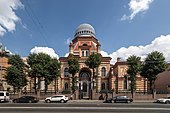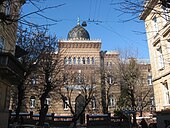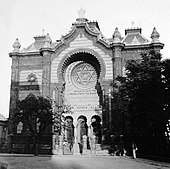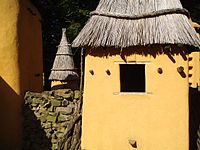Moorish Revival architecture
Last updatedThis article needs additional citations for verification .(December 2007) |

Moorish Revival or Neo-Moorish is one of the exotic revival architectural styles that were adopted by architects of Europe and the Americas in the wake of Romanticist Orientalism. It reached the height of its popularity after the mid-19th century, part of a widening vocabulary of articulated decorative ornament drawn from historical sources beyond familiar classical and Gothic modes. Neo-Moorish architecture drew on elements from classic Moorish architecture and, as a result, from the wider Islamic architecture. [1]
Contents
In Europe
The "Moorish" garden structures built at Sheringham Hall, Norfolk, ca. 1812, were an unusual touch at the time, a parallel to chinoiserie, as a dream vision of fanciful whimsy, not meant to be taken seriously; however, as early as 1826, Edward Blore used Islamic arches, domes of various size and shapes and other details of Near Eastern Islamic architecture to great effect in his design for Alupka Palace in Crimea, a cultural setting that had already been penetrated by authentic Ottoman styles.
By the mid-19th century, the style was adopted by the Jews of Central Europe, who associated Moorish and Mudéjar architectural forms with the golden age of Jewry in medieval Muslim Spain. [3] It has also been argued[ by whom? ] that Jewish communities adopted this architecture (which in Western eyes was seen as stereotypical of "Islamic" or "Oriental" culture more broadly) for more complex reasons; mainly, as an affirmation or reclamation of the Middle Eastern or Semitic roots of their history and thus as a way of setting themselves apart from the surrounding Western or Christian society. [3] [4] This came at time when Jews were gaining more freedoms in some European societies and the construction of ostentatious synagogues was possible for the first time, thus provoking a search for a new distinct style of architecture. Historian John M. Efron of the University of California at Berkeley regards the popularity of Moorish revival architecture among builders of synagogues as a counterpoint to Edward Said's Orientalism, which criticizes European orientalism as inherently imperialist and racist, since the builders chose the style as an expression of admiration for the culture of the Muslim world. [5] As a consequence, Moorish Revival spread around the globe as a preferred style of synagogue architecture for a long period until the early 20th century. [4] [3]

In Spain, the country conceived as the place of origin of Moorish ornamentation, the interest in this sort of architecture fluctuated from province to province. The mainstream was called Neo-Mudéjar. In Catalonia, Antoni Gaudí's profound interest in Mudéjar heritage governed the design of his early works, such as Casa Vicens or Astorga Palace. In Andalusia, the Neo-Mudéjar style gained belated popularity in connection with the Ibero-American Exposition of 1929 and was epitomized by Plaza de España (Seville) and Gran Teatro Falla in Cádiz. In Madrid, the Neo-Mudéjar was a characteristic style of housing and public buildings at the turn of the century, while the 1920s return of interest to the style resulted in such buildings as Las Ventas bullring and Diario ABC office. A Spanish nobleman built the Palazzo Sammezzano, one of Europe's largest and most elaborate Moorish Revival structures, in Tuscany between 1853 and 1889.

Although Carlo Bugatti employed Moorish arcading among the exotic features of his furniture, shown at the 1902 exhibition at Turin, by that time the Moorish Revival was very much on the wane almost everywhere. A notable exceptions were Imperial Russia, where the shell-encrusted Morozov House in Moscow (a stylisation of the Pena National Palace in Sintra), the Neo-Mameluk Dulber palace in Koreiz, and the palace in Likani exemplified the continuing development of the style.
In Hungary
In the Balkans
Another exception was Bosnia, where, after its occupation by Austria-Hungary, the new authorities commissioned a range of Neo-Moorish structures. The aim was to promote Bosnian national identity while avoiding its association with either the Ottoman Empire or the growing pan-Slavic movement by creating an "Islamic architecture of European fantasy". [6] This included application of ornamentations and other Moorish design strategies neither of which had much to do with prior architectural direction of indigenous Bosnian architecture. The central post office in Sarajevo, for example, follows distinct formal characteristics of design like clarity of form, symmetry, and proportion while the interior followed the same doctrine. The National and University Library of Bosnia and Herzegovina in Sarajevo is an example of Pseudo Moorish architectural language using decorations and pointed arches while still integrating other formal elements into the design.
Other notable example in the region is the building of the Regional historical museum in Kardzhali, Bulgaria build in the 1920s, combining also Central Asian styles.

In the United States

In the United States, Washington Irving's fanciful travel sketch, Tales of the Alhambra (1832), first brought Moorish Andalusia into readers' imaginations; one of the first neo-Moorish structures was Iranistan, a mansion of P. T. Barnum in Bridgeport, Connecticut. Constructed in 1848 and destroyed by fire ten years later, this architectural extravaganza "sprouted bulbous domes and horseshoe arches". [7] In the 1860s, the style spread across America, with Olana, the painter Frederic Edwin Church's house overlooking the Hudson River, Castle Garden in Jacksonville and Longwood in Natchez, Mississippi usually cited among the more prominent examples. After the American Civil War, Moorish or Turkish smoking rooms achieved some popularity. There were Moorish details in the interiors created for the Henry Osborne Havemeyer residence on Fifth Avenue by Louis Comfort Tiffany. The most thorough example of Moorish Revival architecture was Villa Zorayda in St. Augustine, Florida, built in 1883 by Franklin W. Smith as a winter home and showplace for the Boston businessman and architectural enthusiast. Today it is a museum, open for tourists. In 1893, The Great Saltair was built on the southern shores of The Great Salt Lake, adjacent to Salt Lake City. Under dozens of Moorish domes and lambrequin, polylobed, and keyhole arches, Saltair housed popular clubs, restaurants, bowling alleys, a hippodrome, rollercoaster, observation deck for the surrounding desert, and what was marketed as the largest dance hall in the world. [8] Like Iranistan before it, Saltair was destroyed by fire in 1925 and again in 1970; the first of which, less than 30 years after opening.
The trend continued into the early 1900s, for example in the 1909 Murat Shrine Temple in Indianapolis, Indiana. The 1914 Pittock Mansion in Portland, Oregon incorporates Turkish design features, as well as French, English, and Italian ones; the smoking room in particular has notable Moorish revival elements. In 1937, the Corn Palace in Mitchell, South Dakota added unusual minarets and Moorish domes, unusual because the polychrome decorations are made out of corn cobs of various colors assembled like mosaic tiles to create patterns. The 1891 Tampa Bay Hotel, whose minarets and Moorish domes are now the pride of the University of Tampa, was a particularly extravagant example of the style. Other schools with Moorish Revival buildings include David H. Zysman Hall at Yeshiva University in New York City. George Washington Smith used the style in his design for the 1920s Isham Beach Estate in Santa Barbara, California. [9]
In India
- Spanish Mosque, built by Viqar-ul-Umra at Hyderabad.
Theaters
In the United States


Around the world
| Theater | Photo | City and State | Country | Architect | Date |
|---|---|---|---|---|---|
| Tbilisi Opera and Ballet Theatre |  | Tbilisi | Georgia | Victor schröter | 1851, rebuilt 1896 |
| Bains Dunkerquois |  | Dunkerque | France | Louis Gilquin | 1896 |
| Odesa Philharmonic Theater |  | Odesa | Ukraine | Alexander Bernardazzi | 1898 |
| State/Forum Theatre | 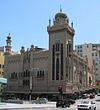 | Melbourne, Victoria | Australia | Bohringer, Taylor & Johnson | 1929 |
| Civic Theatre |  | Auckland | New Zealand | Charles Bohringer and William T. Leighton | 1929 |
Synagogues



Europe
- Munich synagogue, by Friedrich von Gärtner, 1832 was the earliest Moorish revival synagogue (destroyed on Kristallnacht)
- Semper Synagogue, by Gottfried Semper, Dresden, 1839–40 (destroyed on Kristallnacht)
- Leopoldstädter Tempel, Vienna, Austria, 1853–58 (destroyed on Kristallnacht)
- Dohány Street Synagogue, Budapest, Hungary, 1854–1859
- Leipzig synagogue, 1855 (in the Gottschedstrasse, destroyed on Kristallnacht in 1938)
- Glockengasse synagogue, Cologne, Germany, 1855–61 (destroyed on Kristallnacht)
- New Synagogue by Eduard Knoblauch, Berlin, 1859–1866
- New Synagogue, Ostrów Wielkopolski, Poland, 1857–1860
- Tempel Synagogue, Cracow, Poland, 1860–62
- Cetate Synagogue, Timişoara, Romania, by Ignaz Schumann, 1864–65
- Choral Temple, Bucharest, 1864–1866
- Zagreb Synagogue, 1867
- The Great Synagogue of Stockholm, Sweden, by Fredrik Wilhelm Scholander, 1867–1870
- Synagogue of Besançon, France, 1867–1870
- Spanish Synagogue, Prague, 1868
- Rumbach Street synagogue, Budapest, Hungary, 1872
- Czernowitz Synagogue, Chernivtsi, Ukraine, 1873
- Great Synagogue of Florence, Tempio Maggiore, Florence, Italy, 1874–82
- Princes Road Synagogue, Liverpool, England, 1874
- Manchester Jewish Museum, built as a Sephardic synagogue, Manchester, England, 1874
- Vercelli Synagogue, Vercelli, Italy, 1878
- Vrbové synagogue, Vrbové, Slovakia, 1883
- Turin synagogue, Italy, 1884
- Great Synagogue in Pilsen, Pilsen, Bohemia, Czech Republic, 1888
- The Grand Choral Synagogue, St. Petersburg, Russia, 1888
- Esztergom Synagogue, Hungary, 1888
- Fabric New Synagogue in Timişoara, Romania, by Lipot Baumhorn, 1889
- Rosenberg synagogue, Olesno, Poland, 1889 (destroyed on Kristallnacht in 1938)
- La Ferté-sous-Jouarre synagogue, France, 1891
- Hollandse Synagoge, Antwerp, Belgium, 1893
- Second Luxembourg Synagogue, Luxembourg City, Luxembourg, 1894
- Great Choral Synagogue (Kyiv), Ukraine, 1895
- Opava synagogue, Czech Republic, 1895
- Olomouc Synagogue, Olomouc, Czech Republic, 1897 (destroyed in 1938)
- Prešov synagogue, Prešov, Slovakia, 1898
- Košice synagogue, Košice, Slovakia, 1899, interior of Rundbogenstil building
- Malacky synagogue, Slovakia, 1886, rebuilt 1900
- Sarajevo Synagogue, 1902
- Karaite Kenesa, Kyiv, 1902
- Jubilee Synagogue, Prague, Czech Republic, 1906
- Groningen Synagogue, Groningen, Netherlands, 1906
- Choral Synagogue, Minsk, Belarus, 1906
- Bet Israel Synagogue, Belgrade, Serbia, 1908.
- Sofia Synagogue, Sofia, Bulgaria, 1909
- Galitska Synagogue, Kyiv, Ukraine, 1909
- Uzhhorod Synagogue, Uzhhorod, Ukraine, 1910
- Chișinău Choral Synagogue, Moldova, 1913
- Arabian House (Hotel Jadran) Skopje, North Macedonia, 1936–38
United States


- Isaac M. Wise Temple, also known as the Plum Street Temple, Cincinnati, Ohio, 1865
- Congregation Rodeph Shalom, Philadelphia, 1866 (no longer standing)
- Temple Emanu-El on Fifth Avenue at 43rd Street, Congregation Emanu-El of the City of New York built in 1868, designed by Leopold Eidlitz, assisted by Henry Fernbach, (no longer standing)
- B'nai Sholom Temple, Quincy, Illinois, 1870
- Central Synagogue, Upper East Side, Manhattan, New York, 1872
- Vine Street Temple, Nashville, Tennessee, 1874
- Charter Oak Temple (Congregation Beth Israel), Hartford, Connecticut, 1876
- Temple of Israel, Wilmington, North Carolina, 1876 [10]
- B'nai Israel Synagogue (Baltimore), Maryland, 1876
- Temple Adath Israel, Owensboro, Kentucky, 1877
- Prince Street Synagogue (Oheb Shalom,) Newark, New Jersey, 1884
- Eldridge Street Synagogue, Lower East Side, Manhattan, New York, 1887
- Congregation Beth Israel of Portland, Oregon, 1888 (no longer standing)
- Park East Synagogue, Upper East Side, Manhattan, New York, 1889
- Gemiluth Chessed, Port Gibson, Mississippi, 1891
- Temple Emanu-El (Helena, Montana), 1891 [11]
- Temple Beth-El, Corsicana, Corsicana, Navarro County, Texas, 1898–1900
- Temple Sinai (Sumter, South Carolina), 1912
- Young Israel of Flatbush, Midwood, Brooklyn, 1923 [12]
- Ohabei Shalom, Brookline, Massachusetts, 1925
- Congregation Ohab Zedek, Upper West Side, Manhattan, New York, 1926
- Congregation Rodeph Shalom, Philadelphia, 1928
Latin America
- Sephardic Temple, Barracas district, Buenos Aires, Argentina
- Palacio Arabe, downtown Mar del Plata, Argentina, 1945
Churches and cathedrals
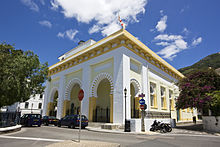
- The Cathedral of the Holy Trinity, Gibraltar (1825–1832) an early example of Moorish revival architecture is located in Gibraltar, which formed part of Moorish Al-Andalus between 711 and 1462 AD.
- Immaculate Conception Church (New Orleans), (a.k.a. Jesuit Church) is a striking example of Moorish Revival Architecture. Across the street was the College of the Immaculate Conception, housing a chapel with two stained glass domes. The chapel was disassembled and about half of it (one of the stained glass domes, eleven of the windows) was installed in the present Jesuit High School.
Shrines and temples


The Shriners, a fraternal organization, often chose a Moorish Revival style for their Temples. Architecturally notable Shriners Temples include:
- Acca Temple Shrine, Richmond, Virginia, currently Altria Theater, formerly 'The Landmark Theater' and 'The Mosque'
- Algeria Shrine Temple, Helena, Montana
- Almas Temple, Washington D.C.
- El Zaribah Shrine Auditorium, Phoenix, Arizona
- Jaffa Shrine Center, Altoona, Pennsylvania
- Jerusalem Temple, New Orleans, Louisiana, built at 1137 St. Charles Avenue in 1918 by architect Emile Weil.
- Medinah Temple, Chicago, Illinois now a Bloomingdale's.
- Murat Shrine, Indianapolis, Indiana, the largest Shrine temple in North America, now officially known as Old National Centre.
- New York City Center, now used as a concert hall
- Shrine Auditorium, Los Angeles, California
- Tripoli Shrine Temple, Milwaukee, Wisconsin
- Zembo Mosque, a Masonic Temple in Harrisburg, Pennsylvania
- The Scottish Rite Temple in Santa Fe, New Mexico, while not a Shrine Temple, is a Masonic building that uses the Moorish Revival architectural style.
- Karem Shrine Temple, Waco, Texas; now Hotel 1928
Other buildings
- Building of the Regional historical museum in Kardzhali, Bulgaria, 1922-1930
- Palace of Manguinhos, site of the Oswaldo Cruz Foundation, in Rio de Janeiro, Brazil, 1905-1918
- "Mosque" shaped steam-generation plant in Sanssouci Park, Potsdam, Prussia, 1842
- The Zacherlfabrik, Vienna, 1892
- City hall, Brcko, Bosnia and Herzegovina, 1892
- City hall, Sarajevo, Bosnia and Herzegovina, 1894
- Jewish Hospital, Lviv, Ukraine, 1900
- Mostar Gymnasium, Mostar, Bosnia and Herzegovina, 1902
- Former Yenidze Cigarette Factory, Dresden, Germany, 1908 (here, the "minarets" are used to disguise smokestacks)
- Gedung Sate, Bandung, Indonesia, 1924
- Casamaures, Saint-Martin-le-Vinoux, France, 1855
- Villa Zorayda, St. Augustine, FL, 1883
- Campo Pequeno bullring, Lisbon, 1892
- Henry B. Plant Museum, Tampa, FL, 1891
- Karlo Helmbold's House (Šeherezada), Zrenjanin, Serbia, by Ištvan Bart, 1900
- Atwater water treatment plant, Canal de l'Aqueduc, Montreal, QC, 1912–18
- Scroll and Key Hall (Yale senior society building, New Haven, CT; 1869 and 1901)
- Palacio de Valle in Cienfuegos, Cuba (1913–17)
- The Citadel, a military college in Charleston, South Carolina
Gallery
- Immaculate Conception Church (New Orleans), 1851, rebuilt 1930
- Leopoldstädter Tempel, Vienna, Austria, 1858
- Spanish Synagogue (Prague), Czech Republic, 1868
- Florence synagogue, Italy, 1882
- Turin synagogue, Italy, 1884
- Fabric New Synagogue in Timişoara, Romania, 1889
- Tampa Bay Hotel, Tampa, Florida, 1891
- The Grand Choral Synagogue, St. Petersburg, Russia, 1893
- Great Synagogue, Plzeň, Czech Republic, 1893
- The Palace of Manguinhos in Rio de Janeiro, Brazil
- Likani Palace, Georgia, 1895
- Arseny Morozov House, Moscow, Russia, 1899
- Former Jewish Hospital in Lviv, Ukraine, 1901
- Mostar Gymnasium, Mostar, Bosnia and Herzegovina, 1902
- Uzhhorod Synagogue, 1910
- Hotel Jadran (Arabian house) in Skopje, North Macedonia, 1938
- Kórnik Castle, Poland
- Scroll and Key Hall; New Haven, Connecticut (Yale senior society building). This is a proposed plan of ca. 1867. Only far left structure was built.
- History Museum, Kardzhali, Bulgaria
See also
Notes
- ↑ Giese, Francine; Varela Braga, Ariane; Lahoz Kopiske, Helena; Kaufmann, Katrin; Castro Royo, Laura; Keller, Sarah (2016). "Resplendence of al-Andalus: Exchange and Transfer Processes in Mudéjar and Neo-Moorish Architecture" (PDF). Asiatische Studien - Études Asiatiques. 70 (4): 1307–1353. doi:10.1515/asia-2016-0499. S2CID 99943973.
- ↑ Brett, C.E.B. (2005). Towers of Crim Tartary : English and Scottish architects and craftsmen in the Crimea, 1762–1853. Donington, Lincolnshire: Shaun Tyas. p. 65. ISBN 978-1-900289-73-3.
- 1 2 3 "Why Moorish? Synagogues and the Moorish Revival". Museum at Eldridge Street. 2017-04-27. Retrieved 2019-11-17.
- 1 2 Kalmar, Ivan Davidson (2001). "Moorish Style: Orientalism, the Jews, and Synagogue Architecture". Jewish Social Studies. 7 (3): 68–100. doi:10.2979/JSS.2001.7.3.68. hdl: 1807/35319 . S2CID 162229425 – via JSTOR.
- ↑ Biale, David (June 2017). "German Jewry and the Allure of the Sephardic (book review)". The American Historical Review. 122 (3): 942. doi:10.1093/ahr/122.3.942.
- ↑ Joseph, Suad; Najmabadi, Afsaneh (2003). Encyclopedia of Women & Islamic Cultures: Economics, education, mobility, and space. Brill Publishers. ISBN 9004128204.
- ↑ John C. Poppeliers, S. Allen Chambers Jr. What Style Is It: A Guide to American Architecture, p. 63. ISBN 0-471-25036-8 .
- ↑ Utah Division of State History (19 May 2016). "Saltair: A Photographic Exhibit" . Retrieved 16 January 2023.
- ↑ Gebhard, David. Santa Barbara Architecture, from Spanish Colonial to Modern. Capra Press. Santa Barbara. 1980. (later editions avail.) p. 109
- ↑ "View, Temple of Israel, Wilmington, North Carolina", NC State University Libraries. Retrieved August 23, 2021.
- ↑ "National Register". Archived from the original on 2012-08-03. Retrieved 2012-08-15.
- ↑ BJHI Author (December 5, 2013) "Young Israel Of Flatbush", Brooklyn Jewish Historical Initiative. Retrieved August 23, 2021.
Sources
- Naylor, David (1987). Great American Movie Theaters. Washington, D.C.: The Preservation Press. ISBN 9780891331278.
- Thorne, Ross (1976). Picture Palace Architecture in Australia. South Melbourne, Australia: Sun Books Pty. Ltd. ISBN 072510225X.
External links
Related Research Articles

A synagogue, also called a shul or a temple, is a place of worship for Jews and Samaritans. It has a place for prayer where Jews attend religious services or special ceremonies such as weddings, bar and bat mitzvahs, choir performances, and children's plays. They also have rooms for study, social halls, administrative and charitable offices, classrooms for religious and Hebrew studies, and many places to sit and congregate. They often display commemorative, historic, or modern artwork alongside items of Jewish historical significance or history about the synagogue itself.

Synagogue architecture often follows styles in vogue at the place and time of construction. There is no set blueprint for synagogues and the architectural shapes and interior designs of synagogues vary greatly. According to tradition, the Shekhinah or divine presence can be found wherever there is a minyan, a quorum, of ten. A synagogue always contains an Torah ark where the Torah scrolls are kept, called the aron qodesh by Ashkenazi Jews and the hekhal by Sephardic Jews.

Mudéjar art, or Mudéjar style, was a type of ornamentation and decoration used in the Iberian Christian kingdoms, primarily between the 13th and 16th centuries. It was applied to Romanesque, Gothic and Renaissance architectural styles as constructive, ornamental and decorative motifs derived from those that had been brought to or developed in Al-Andalus. These motifs and techniques were also present in the art and crafts, especially Hispano-Moresque lustreware that was once widely exported across Europe from southern and eastern Spain at the time.
The architecture of Bosnia and Herzegovina is largely influenced by four major periods, when political and social changes determined the creation of distinct cultural and architectural habits of the region.

The Leopoldstädter Tempel was the largest synagogue of Vienna, in the district (Bezirk) of Leopoldstadt. It was also known as the Israelitische Bethaus in der Wiener Vorstadt Leopoldstadt. It was built in 1858 in a Moorish Revival style by the architect Ludwig Förster. The tripartite facade of the Leopoldstädter, with its tall central section flanked by lower wings on each side, became the model for numerous Moorish Revival synagogues, including the Choral Temple in Bucharest, which has an almost identical main facade, the Zagreb Synagogue, the Spanish Synagogue in Prague, the Tempel Synagogue in Kraków and the Grand Synagogue of Edirne.

Spanish architecture refers to architecture in any area of what is now Spain, and by Spanish architects worldwide. The term includes buildings which were constructed within the current borders of Spain prior to its existence as a nation, when the land was called Iberia, Hispania, or was divided between several Christian and Muslim kingdoms. Spanish architecture demonstrates great historical and geographical diversity, depending on the historical period. It developed along similar lines as other architectural styles around the Mediterranean and from Central and Northern Europe, although some Spanish constructions are unique.

Moorish architecture is a style within Islamic architecture which developed in the western Islamic world, including al-Andalus and what is now Morocco, Algeria, and Tunisia. Scholarly references on Islamic architecture often refer to this architectural tradition in terms such as architecture of the Islamic West or architecture of the Western Islamic lands. The use of the term "Moorish" comes from the historical Western European designation of the Muslim inhabitants of these regions as "Moors". Some references on Islamic art and architecture consider this term to be outdated or contested.

The Tripoli Shrine Temple is a Shriners temple built 1926-28 in the Concordia neighborhood of Milwaukee, Wisconsin. The building's design incorporates Moorish and Indian elements, somewhat resembling the Taj Mahal in India, and is listed on the National Register of Historic Places as Tripoli Temple. It is not a religious building.
Neo-Mudéjar is a type of Moorish Revival architecture practised in the Iberian Peninsula and to a far lesser extent in Ibero-America. This architectural movement emerged as a revival of Mudéjar style. It was an architectural trend of the late 19th and early 20th centuries that began in Madrid and Barcelona and quickly spread to other regions in Spain and Portugal. It used Mudéjar style elements such as the horseshoe arch, arabesque tiling, and abstract shaped brick ornamentations for the façades of modern buildings.

Portuguese architecture refers to both the architecture of Portugal's modern-day territory in Continental Portugal, the Azores and Madeira, as well as the architectural heritage/patrimony of Portuguese architects and styles throughout the world, particularly in countries formerly part of the Portuguese Empire.

KAM Isaiah Israel is a Reform Jewish congregation and synagogue located at 1100 East Hyde Park Boulevard in the historic Kenwood neighborhood of Chicago, Illinois, in the United States. It is the oldest Jewish congregation in Chicago, with its oldest core founded in 1847 as Kehilath Anshe Ma'arav.

Art of Bosnia and Herzegovina refers to artistic objects created by the inhabitants of Bosnia and Herzegovina from prehistory to present times.

Congregation Beth Israel is a Reform Jewish congregation and synagogue, located at 1931 NW Flanders Street, Portland, Oregon, in the United States.
Temple Israel is a Reform Jewish congregation and synagogue located at 330 Joe Clifton Drive, in Paducah, Kentucky, in the United States.

Congregation Adath Israel Brith Sholom is a Reform Jewish congregation and synagogue located at 5101 US Hwy 42, in Louisville, Kentucky, in the United States.
Temple Shalom is a Reform Jewish synagogue located at 23 Bethany Pike, Wheeling, West Virginia, in the United States. The congregation dates from 1849, with the current synagogue building completed in 1957, as the Woodside Temple.

Centuries before the Ottoman conquest of Bosnia, Mostar was a small hamlet situated at a strategic crossing of the Neretva river. Its hinterlands consisted of a broad agricultural plain on the west bank and steep terraces on the east bank surrounded by barren mountains. Mostar was a representative multi-ethnic and multi-cultural settlement in Bosnia and Herzegovina, which had possessed an independent political identity since the twelfth century. By the fifteenth century, most of the lands that would later become part of modern Yugoslavia were inhabited primarily by peoples of the same south Slavic heritage.

Karel Pařík was a Czech-born architect in the Austro-Hungarian empire. Pařík spent most of his life in Sarajevo where he designed over seventy major buildings, which are today classified among the most beautiful in Bosnia and Herzegovina. For Bosnians, he is also known as Karlo Paržik and is considered as "The builder of Sarajevo". He died working on his last project, Sarajevo City Hall, which later became one of the symbols of the city. "Czech by birth, Sarajevan by choice" stands encrypted on his gravestone in Sarajevo.

In 1878 the Austro-Hungarian Empire occupied Bosnia and Herzegovina and in 40 years had an immense influence in future urban planning and architecture. Stylistically, Bosnia was to be assimilated into the European mainstream, save for the appearance of the Orientalist style.

Hotel Neretva is a hotel in Mostar, Bosnia and Herzegovina. It was designed in 1890. by architect Alexander Wittek and built in a specific pseudo-Moorish style, which was dominant from the end of the 19th century, on the left bank of the Neretva river, in the heart of Old town of Mostar, in 1892, during the Austro-Hungarian rule in Bosnia and Herzegovina.
Text is available under the CC BY-SA 4.0 license; additional terms may apply.
Images, videos and audio are available under their respective licenses.









